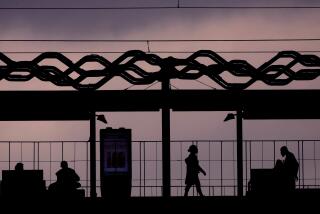Died in Crash of Vintage Plane : Flier Honored in Hero’s Funeral
Merrel Gossman, a laconic, one-legged flooring contractor who never heard a shot fired in anger, was given a military hero’s funeral Saturday by the old warriors whose respect he craved and won--for his heart, not his service record.
Gossman, 55, who died when his World War II-era plane crashed in Orange County last week, was honored with a “missing man” fly-past in a service at the Van Nuys Airport headquarters of the Condor Squadron, a civilian flying club made up mostly of middle-aged former fighter pilots.
Gossman was never a military pilot, but his friends gave him the send-off they thought he deserved.
An honor guard of Marines and about three dozen men in the uniforms of other military services stood at attention on the lawn of the squadron’s clubhouse, a replica of a World War II Air Corps officer’s club beside the airport runway. An improvised altar was flanked by rifles upended in the earth on their bayonets, helmets atop the stocks.
8 Planes Swoop Down
Eight immaculately preserved and brightly polished AT-6 planes, the 40-year-old-plus fighter trainers the squadron members fly, circled in the sky as the service began.
On cue, they swooped over Roscoe Boulevard and flashed down the runway in close formation at 1,000 feet in two lines of four planes each.
As an organist on the lawn pumped out the Marine Corps Hymn, the plane at the right end of the second line--Gossman’s usual place--banked sharply westward and disappeared into the sun as they passed the club. The seven remaining planes climbed over Encino toward the Santa Monica Mountains, leaving a hole in the formation to represent the lost Gossman.
The Marines fired three volleys over a wreath wrapped in a ribbon bearing the words “Our Buddy.” A bugler blew retreat. A Marine Corps colonel gave Gossman’s widow, Tina, the flag that had earlier covered his coffin.
Funeral Tradition
The “missing man” salute is a funeral tradition for military pilots. U.S. Air Force historians say it appears to have originated in Britain’s Royal Air Force and spread to the U.S. Army Air Corps in the 1930s.
Gossman was never a fighter pilot, said other members of the squadron, old friends and members of his family.
Unlike virtually all the club’s members, he was never a military pilot. He was in the Marine Corps, as an enlisted man, but apparently served from 1947 to 1949, after World War II had ended and before the Korean War began.
He kept up ties to the Marines. It was he who arranged for the squadron to participate in an air show at El Toro Marine Corps Air Station, where he died. He was taking a Navy hospitalman he had just met for a ride when his plane lost power on takeoff and crashed into an empty chapel, killing them both.
Desire Fulfilled
Acceptance by the Condor Squadron, said some old friends, was one of his deepest desires.
Although he had lost his right leg in a hunting accident after leaving the Marines, he ignored his handicap, they said. He learned to fly and persisted until he was accepted as an airline pilot, flying commercially for eight years.
It was his flying skill, dedication and casual rejection of his handicap that won him acceptance in the club, some members said.
“I remember when he was finally accepted by the squadron, he was happier than I’d ever seen him before,” a friend who had known him for 30 years said recently. “He wanted to be in that group more than anything, except maybe to be a priest.”
Gossman lost his leg when a priest accidentally fired a shotgun into his thigh during a hunting trip while he was a student for the priesthood at a Catholic monastery in the South, family and friends said. Those who knew him in college said he told them that the loss of the leg made him ineligible to remain at the monastery, and he often talked of trying to return to the religious life.
Family, Business
Instead, he married, had three sons, divorced, married again and went into the floor-covering business after leaving commercial flying.
Gossman became a celebrity in the Condor Squadron by flying his AT-6, designed for short training flights, from Van Nuys to England and back in 1982, crossing the North Atlantic in bad weather, alone. It was a flying feat the other squadron members marveled at.
He said he wanted to see England because he was a fan of the Royal Air Force. Alongside the concrete pad where he parked his plane, which stood in a row with the other squadron planes, was a sign “Biggin Hill,” the name of an RAF base in England that was home to many of the fighter planes that won the Battle of Britain.
Behind the sign is a flagpole, where he flew an RAF flag or the Marine Corps flag.
Flag at Half-Staff
The Marine flag hung at half-staff and the empty pad was covered with flowers Saturday as the other pilots in the squadron flew past, led by Richard Sykes, a Toluca Lake lawyer, and Charles Beck, a building contractor from Olivenhain in San Diego County.
Sykes flew P-38s in Europe. Beck flew P-51s.
The “missing” plane, piloted by Ray Schutte of Valencia, a retired city helicopter pilot who flew C-47s in World War II, continued west over the ocean. From the rear cockpit of the two-seat trainer plane, Jake Jacobbauski, 59, of Van Nuys, a former B-17 gunner, scattered Gossman’s ashes over the sea.
More to Read
Sign up for Essential California
The most important California stories and recommendations in your inbox every morning.
You may occasionally receive promotional content from the Los Angeles Times.










